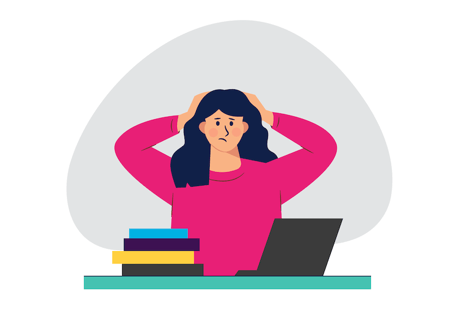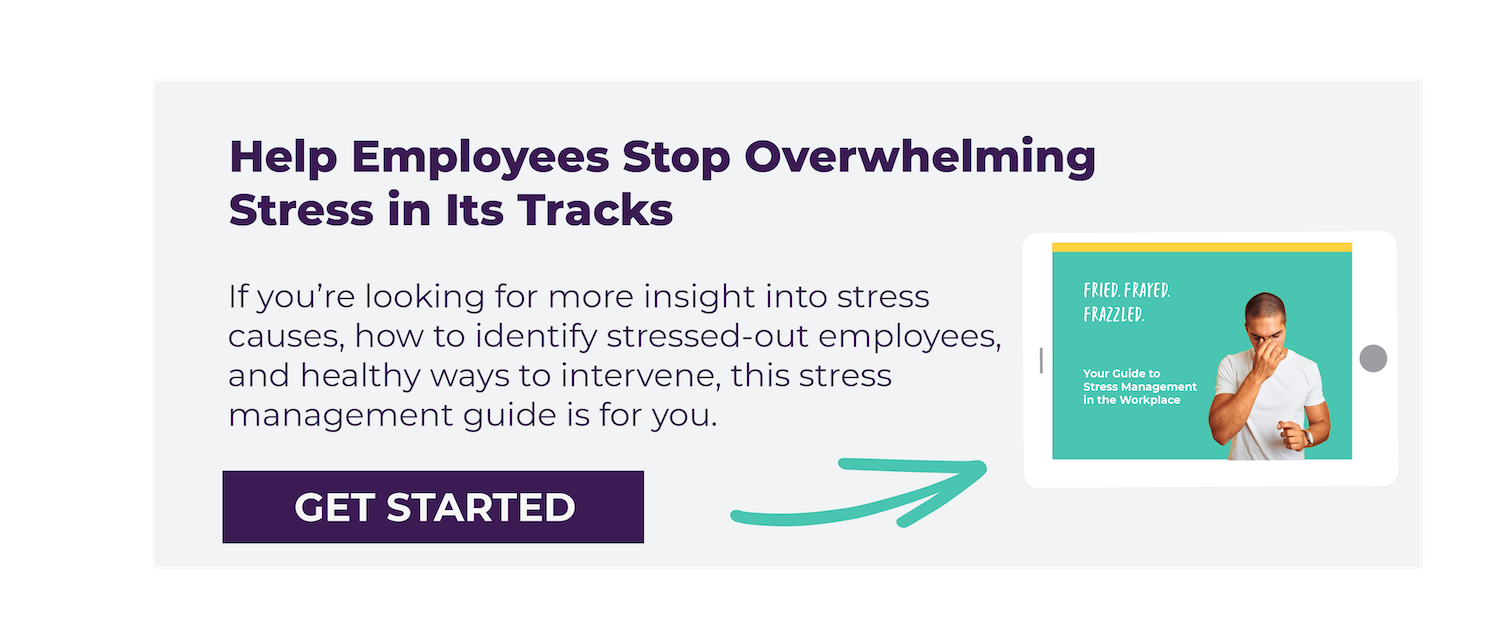 Even for employees who love their jobs, work-related stressors still happen.
Even for employees who love their jobs, work-related stressors still happen.
In fact, a recent survey from Future Forum compiled results from 10,000 workers globally showing anxiety and stress levels in the workplace are at their highest since June 2020. In-house workers in particular were found to have 1.5 times worsening work-related stress and anxiety compared to remote workers.
Without a doubt, the pandemic’s lingering effects don’t just include long-haul COVID. Some are still grappling with being back in the office, work-life balance, staff shortages, anxiety, and other life and work stressors. Even pre-COVID, the American Psychological Association found work to be one of the top stress sources for Americans.
Below, learn more about the top work-related stressors that may be impacting your employees and how to help them better manage work-related stress.
The Most Common Work-Related Stressors
Workplace stressors vary from organization to organization, but almost every employee at one point or another experiences it. The severity of it depends on a multitude of factors, too: Everything from a person’s natural temperament to management styles and available stress reduction resources.
A few reasons for work stress:
- Low salaries
- Long hours
- Harassment
- High expectations
- Discrimination
- Lack of growth options
- Excessive workloads
Other sources of work-related stress may include personality conflicts, lack of support, and even a toxic work culture.
The Negative Health Impacts of Stress
It’s important to not underestimate the role stress can play on one’s health and overall well-being. Many people often shrug it off as part of life, but left unchecked, it can have devastating impacts on the body’s various organs, tissues, and systems.
Key body systems that are impacted by long-term and even short-term stress include the nervous system, respiratory system, musculoskeletal system, endocrine system, gastrointestinal system, cardiovascular system, and reproductive system. From a pounding heart to headaches and tense muscles to high blood pressure, stress can make the body react quickly and intensely.
Here’s a look at how it can impact the body:
Physical Stress Symptoms
- Shaking
- Exhaustion
- Headaches
- Dizziness
- Chest pain
- Low energy
- High blood pressure
- Muscle tension or jaw clenching
- Stomach or digestive problems
Psychological Stress Symptoms
- Avoiding others
- Easily agitated or moody
- Difficulty quieting the mind or relaxing
- Feeling more emotional than usual
- Using substances like alcohol to relieve stress
The physical and mental signs of stress vary person-to-person. Consider them as “warning signs” your body is giving you to slow down. Long-term stress can turn into chronic health conditions if left unmanaged.
Note: Stress and anxiety may feel very similar — a faster heartbeat and heavy breathing, for example — but are different. Stress is often a short-term response to a recognized threat whereas anxiety can linger longer and may not always have an easily identifiable trigger.
Related: Anxiety vs. Stress: Why Employers Need to Know the Difference
The Impact on Work Due to Stress
Because of the amount of physical and mental energy stress can take from the body, individuals have fewer resources and means to focus on other important activities — like work. This means they may be more prone to mistakes, judgment errors, or even have more injuries. Their mind, essentially, is “elsewhere” making it hard to concentrate on doing anything other than surviving the stress.
Benefits of Preventing Workplace Stress
Stress isn’t simply an “emotion” to sweep under the rug. In the workplace, leaving stressors unattended can have devastating impacts on workflow, loyalty, employee satisfaction, and production.
An employer who takes stress prevention seriously will see reduced symptoms of poor mental and physical health, increased productivity, increased work engagement, and improved employee health and community wellbeing.
Help Employees Manage Stress Better
Managers may have more control over how stressed-out their employees feel than they might think. Without a doubt, it is one of the many challenging aspects of being a leader — managing your team in a healthy way.
Ways to tackle work-related stressors:
- Meditation Mondays - Don’t let Mondays turn frantic because of last week’s leftover work. Instead, invite your team to tackle the week with a relaxed, happy attitude. Consider starting the day with a group meditation, nature walk, or even a yoga session. Doing so creates a more calm environment that is easier to work in than one filled with tense stress.
- Cut Down Overtime - Do your employees really need to be working all those overtime hours? If you’re noticing symptoms of overwhelm and burnout, see if you can dial back the number of hours your team works. Overtime hours are often associated with increased stress, according to research.
- Increase Awareness Around Stress - Part of training your employees in stress management includes being aware of what may constitute a stressed-out body. Help your employees learn how to listen to their bodies more closely so they know when it’s time to focus on some self-care.
- Manage Expectations - It’s important to remember that the people working under you are just that — imperfect humans — and not robots designed to output perfect work every time. By managing appropriate expectations and remembering what skills your team has, it makes it easier to not get frustrated. That, in turn, can keep your team feeling useful instead of useless. Release the idea of perfection and manage your team in a way that doesn’t expect perfection.
- Create an Open Door Policy - Let employees know they can talk to their supervisor or immediate manager when it comes to stressful work situations. Evidence shows employee health is highly linked to productivity, so managers need to know how they can keep work environments healthy. When an employee comes forth with insight into workplace stressors, work together to come up with an effective plan to tackle the stressors.
As for individual employees, it’s also on them to understand what their stress thresholds are and how to avoid exceeding those. It can be easy to take excessive stress out on colleagues or loved ones, but that is also damaging to relationships. When employees and employers work together to keep work stress minimal and manageable, it creates a healthier workplace and community in the long haul.
How do you help your employees deal with work stressors? Share your advice down below!



